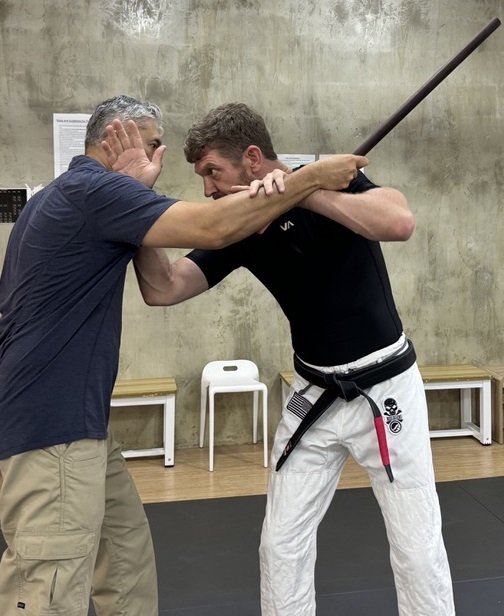Importance of Personal Safety and Self-Defense Training
Security officers are first responders. Whether diffusing cautionary situations, controlling assailants, or responding to security breaches, security practitioners must be trained to protect themselves and others during volatile circumstances. Personal safety and self-defence proficiency are paramount for security professionals to effectively perform their duties with confidence and competence.
Situational awareness, effective communication, mental aptitude, and specialized self-defence training are essential to mitigate threats and respond appropriately.
Investing in personal safety and self-defence training will provide your organization’s security team with the knowledge, skills, and capabilities required to perform
We offer self-defence, personal protection and safety training for a variety of environments and situations. Courses are tailored to address client organization posture and security personnel skill requirements. We can train conventional unarmed confrontation incidents or high-threat situations involving hand-held or improvised weapons.
Your first step in protecting yourself and your loved ones begins here.
WHAT will be covered in this course
-
a. Hand-to-Hand Combat Techniques
Effective hand-to-hand combat techniques are invaluable to security officers confronted with direct physical aggression or violence. Training in martial arts or close-quarters combat provides security officers with the skills to defend themselves and neutralize threats without relying solely on external tools or weapons. These techniques emphasize control, restraint, and the ability to subdue an aggressor with minimal harm.
b. Non-Lethal Device Use
In situations where physical intervention is necessary, security know and be able to apply appropriate non-lethal force options. This includes use of batons, pepper spray, and other improvised tools, with a focus on employing them responsibly and within the bounds of the law. Proper training ensures that security professionals can effectively deter and subdue aggressors while minimizing the risk of unwarranted harm.
c. Weapon Retention and Disarming
Security professionals who carry firearms, weapons, or other protection devices require specialized training in retention and disarming techniques. This specialized training focuses on safeguarding the officer’s weapon or device from being taken and, if necessary, disarming an armed assailant. Skill in these procedures enhances an officer’s ability to maintain control of their equipment while responding to a threat incident.
-
1. Situational Awareness and Evaluation
Students will learn situational awareness skills identify and evaluate potential threats and anomalies. This includes recognizing suspicious behavior, monitoring access points, and being attentive to surrounding activities. Training focuses on improving observational skills to notice relevant details in the environment. This includes recognizing cues, patterns, and changes that could indicate potential threats or opportunities.
2. Risk Assessment and Mitigation
Recognize potential risks and hazards in particular environments and during security routines. After understanding these risks, students will learn proactive measures to mitigate known risks before incidents occur. Many industries and organizations are required by law to conduct regular risk assessments to ensure compliance with safety regulations and standards. Proper training ensures that these assessments are conducted correctly and comprehensively.
3. Effective Communication and Conflict Resolution
Effective communication is critical in maintaining situational awareness. Training may cover techniques for clear and timely information sharing among team members or with relevant stakeholders. Training in conflict resolution provides students with the tools to manage potentially aggressive interactions and methods to prevent violence. Students will learn effective verbal and non-verbal communication skills to de-escalate conflict and diffuse tense situations.
4. Self-Defense Skills and Levels Trained
Level 1. Essential Training: Students learn fundamentals of self-defense and personal safety. Students will learn effective, specialized, and proven tactics and techniques focused on single and multiple attackers with an intent to harm. Training includes blocking, striking, grappling, and controlling an assailant. Course instruction focuses on mastering select techniques to defend the most common physical threats and attacks to security first responders. Instructors teach distance, angles and stance and applying leverage to defend and counter aggressive attacks. Situational awareness suitable for a broad range of security environments with self-defense applications focused on essential techniques and principles to.
Level 2. Advanced Training: Students learn defensive strategies and techniques for more complex or uncertain situations, including scenarios with heightened stress levels. Advanced self-defense training builds upon the essential skills with more sophisticated techniques and combinations. This includes grappling, joint locks, and use of pressure points and precise strikes aimed at vulnerable areas. Advanced training also includes strategies for influencing an attacker's mindset or exploiting vulnerabilities.
Level 3. Instructor Training: Instructor training emphasizes refinement and mastery of techniques taught in the essential and advanced levels. Instructor training is a "train the trainer" program intended to build a cadre of skilled instructors to transfer knowledge, promote learning, and contribute to organization's self-defense and personal safety program. The course focuses on developing higher proficiency and confidence with emphasis on supervising practical exercises and simulations that replicate real-world scenarios. Trainers learn how to create and manage these scenarios effectively, allowing them to train others in realistic and controlled environments.
-
Scenario-Based Exercises: Practical exercises and simulations are incorporated in all training. Scenarios replicate realistic situations to allow participants to apply newly learned skills, assess performance, and learn by application. All instructors have applied all course training during real-world events.
Feedback and Reflection: Training includes performance feedback after exercises. This helps participants identify strengths, areas for improvement, and strategies to enhance skills and execution response.
COURSE DURATION
Basic Personal Safety and Self-Defense Course
3 weeks classroom
Advanced Personal Safety and Self-Defense
2 week classroom*
* Basic PSSDC prerequisite
Instructor in Personal Safety and Self-Defense
1 week classroom**
** Advanced PSSDC prerequisite



